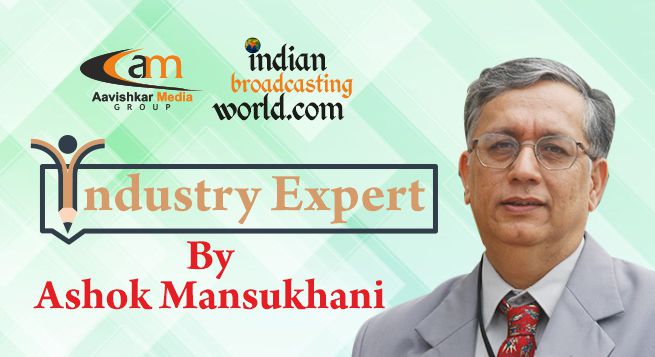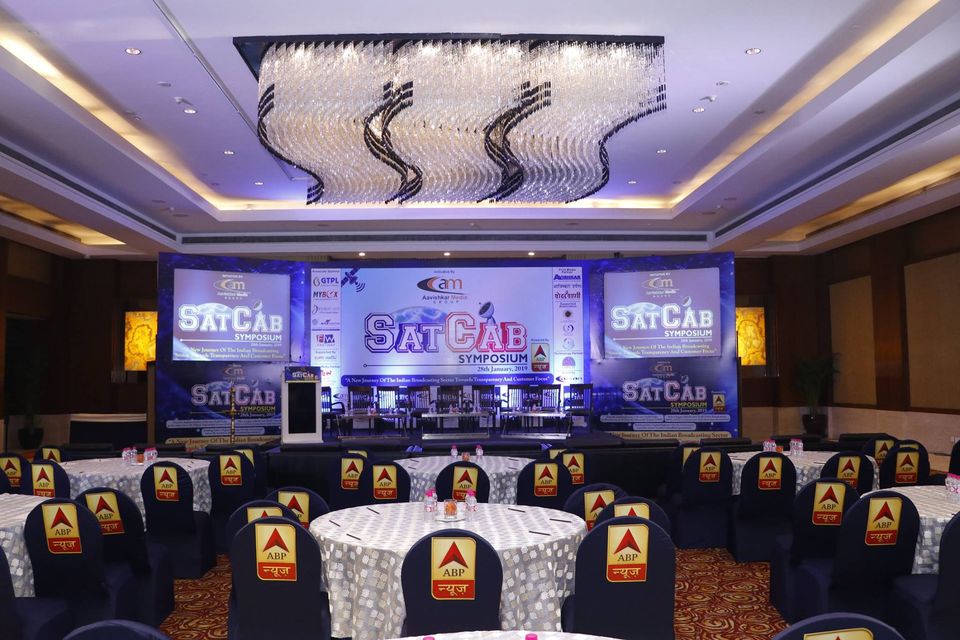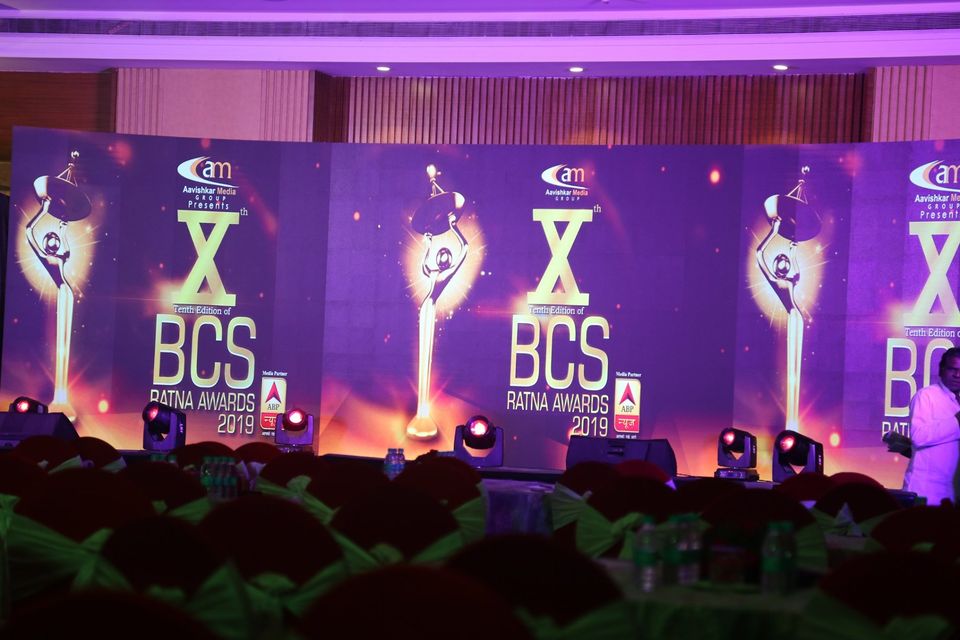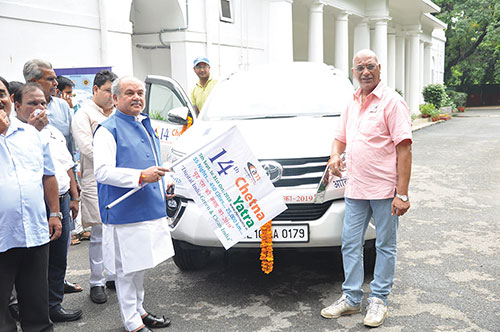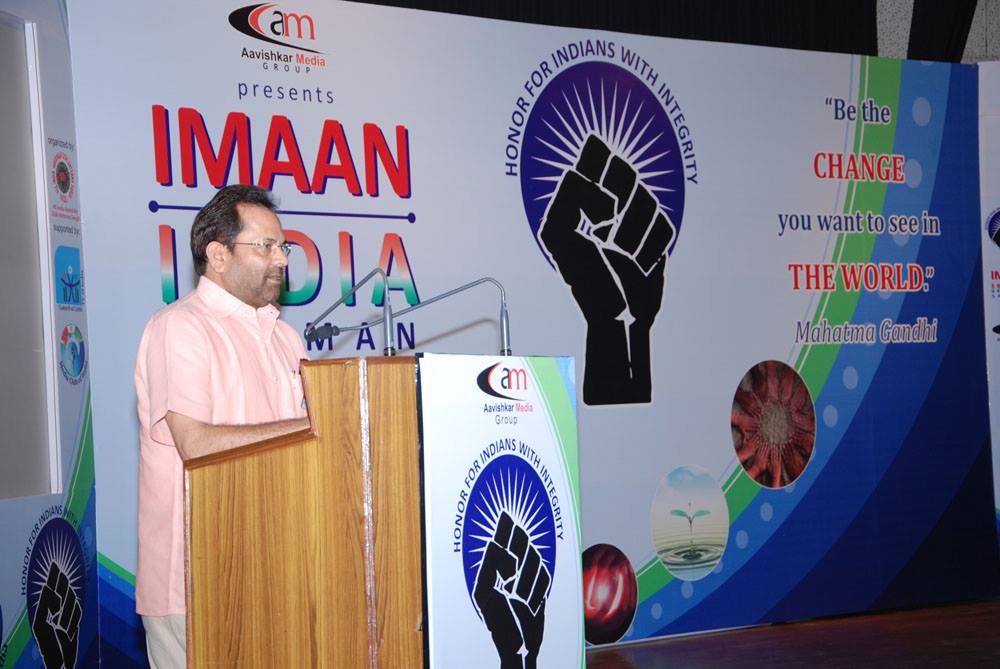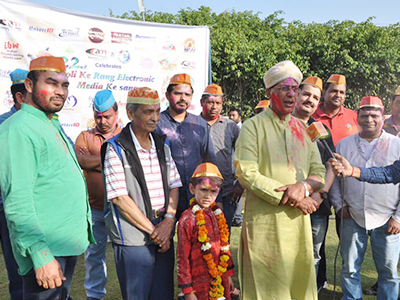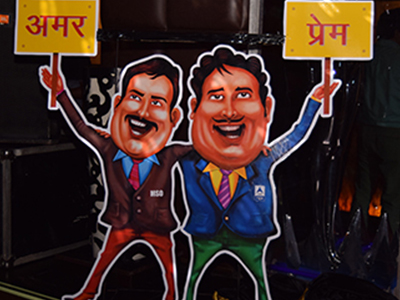Serious Constitutional Challenges under Article 19 (1) (a)
Battle of Broadcasters shifts to Supreme Court
Bombay High Court Judgment
A. On 06.2021, the Bombay High Court decided a batch of appeals against the amended TRAI Regulations/Tariff Orders dated 01.01.2020 filed by the Film and Television Producers Guild of India Ltd, Seven Broadcasters & the Indian Broadcasting Federation vs TRAI/UOI in Civil Writ Petitions Nos 116/2020/;117/2020/; 118/2020; 120/2020; 124/2020; 125/2020; 126/2020; 127/2020 and 147/2020 challenging the constitutional validity of the following Regulations and Tariff Orders:
- The Telecommunication (Broadcasting and Cable) Services Interconnections (Addressable Systems) (Second Amendment) Regulations, 2020,
- Telecommunication (Broadcasting and Cable) Standard of Quality of Service and Consumer Protection (Addressable Systems) (Third Amendment) Regulations 2020 (hereinafter referred to as “2020 Regulations Amendments”) and
- The Telecommunication (Broadcasting and Cable) Services (Eighth)
- (Addressable Systems) Tariff (Second Amendment) Order, 2020 (hereinafter referred to as “2020 Tariff Order Amendment”) issued in exercise of powers under the Telecom Regulatory Authority of India Act, 1997 (hereinafter referred to as the TRAI Act).
NOTE:– Indian Broadcasting Federation and six other Broadcasters filed a Special Leave Petition in the Supreme Court dated July 13, 2021, challenging the Bombay High Court judgment of 30.06.2021vide SLP (C)01081/2021.
At its hearing on August 6, 2021, the Supreme Court led by the Chief Justice made strong remarks against highly bulky filings by some petitioners. The reference was also directed to the Broadcaster Appeals wherein 51 volumes of petitions were filed and “a lorry had to be arranged” for carrying them to the Judges. The Court wondered whether the purpose was to “terrorise judges not to read the petitions.”
The Court refused to hear the appeals on that date. It postponed the hearing to August 18, 2021, with a direction to the Petitioners to make “a convenience volume of all the documents in consultation with the Respondents, in consultation with the learned senior counsel appearing for the Respondents well in advance and circulate the same”.
The matters are now listed on August 18, 2021, for admission.
B. Extracts of Bombay High Court Judgment 30.06.2021
1. Constitutional Validity of Tariff Order and Regulations
The issues raised in the Petitions are set out hereunder:
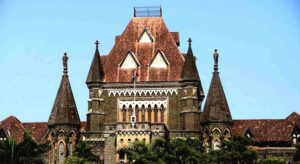
(i)Whether Section 11 of the Telecom Regulatory Authority of India Act, 1997 violates the Petitioners’ fundamental rights under Articles 19(1) (a),19(1) (g), 14 and 21 of the Constitution of India. It ought to be declared constitutionally invalid, as far as it relates to Broadcasting Services.
(ii) Whether the impugned Principal 2017 Regulations and Principal2017 Tariff Order (i.e., Principal 2017 provisions) violate the Petitioners’ Fundamental Rights under Articles 19(1) (a), 19(1)(g),14 and 21 of the Constitution of India and ought to be declared constitutionally invalid?
(iii) Whether the impugned 2020 Regulations Amendments and 2020Tariff Order Amendment (i.e.,2020Amendments) violate the Petitioners’ fundamental rights under Articles 19(1) (a), 19(1)(g),14 and 21 of the Constitution of India and ought to be declared constitutionally invalid? Para 5.
2. Constitutional Challenge to Section 11 (Paras 4-50 of the Judgment)
- The gravamen of the Petitioners’ challenge to Section 11 of the TRAI Act is Section 11(2). Section 11(2) empowers the Authority to fix rates of Telecommunication services, which includes Broadcasting Services, with which we are concerned in the present case. The Petitioners have fundamentally premised their challenge to Section 11(2) of the TRAI Act on the ground that it grants unlimited power to TRAI to curb the Petitioners’ freedom of speech and expression under Article 19(1)(a) of the Constitution. Para 5.
- The broad select submissions of the learned Senior Counsel/Counsel for the Petitioners on the challenge to Section 11 as being violative of the fundamental rights under Article 19(1)(a) are as follows:
- i) The fixation of rates or price in the exercise of the right of speech and expression is by its very nature and character a limitation or restriction on the freedom of speech and expression protected under Article 19(1)(a) of the Constitution. Restrictions under Article 19(2) of the Constitution can only be confined to the eight specified grounds and no other. The interest of the general public is not a ground available under Article 19(2). A law that infringes the right under Article19(1)(a) cannot be saved with reference to consideration of public interest.
- iv) Being an individual right under Article 19(1)(a) of the Constitution, there is no question of balancing interests, which is permissible only under Article 19(1)(g) of the Constitution – it is not a societal right or a community right or a public right, unlike price fixation which is a right in the interest of the general public or consumer or society.
- v) The intention and direct effect of impugned Section 11 are to limit and interfere with various facets of the right guaranteed under Article19(1)(a), including circulation.
- vi). The scope of freedom of speech is qualitative and quantitative, i.e., it lies both in content and circulation. The release of speech and expression under Article 19(1)(a) of the Constitution of India includes within its scope, at least the following four aspects–
(a) freedom to choose the content of the expression.
(b) freedom to circulate and disseminate the expression to the widest extent possible.
(c) freedom to choose the means of exercising the right; and
(d) freedom to be independent such that restrictions do not undermine its independence.
- viii) Section 11 suffers from the vice of excessive delegation of power by the legislature in favour of TRAI and gives wide and unbridled power to regulate various aspects of Broadcasting Services, including packaging/offering of bouquet formations and pricing. There is a lack of guidance or guidelines to TRAI, which has resulted in TRAI arbitrarily and unreasonably restricting the reach/dissemination of content/programmes through television channels.
- ix) It is lastly contended, in the alternative, that Section 11 of the TRAI Act may be read down to say that fixation of rates is only restricted qua carriage/infrastructure/interconnection aspects of Broadcasting Services and does not encompass any fixation of rates and other commercial terms at which TV channels (which are an expression of free speech) are offered.
Para 8.
3. Sheet Anchor of Petitioner’s Case/Respondents Reply
- The sheet anchor of the Petitioners’ case is the Judgment of the Constitution Bench of the Supreme Court in Sakal Papers Ltd. vs Union of India, (1962) 3 SCR 842[which involved a challenge to the constitutionality of the Newspaper (Price and Page) Act, 1956 and the Daily Newspaper (Price and Page) Order, 1960 by the private newspaper that published daily and weekly editions], cited by all the learned Senior Counsel/Counsel on behalf of the Petitioners. Inviting our attention to Paragraphs 24, 25, 28, 31, 32, 33-38, it is contended that the Judgment in Sakal Papers thoroughly answers the case of the Petitioners.
Para 9.
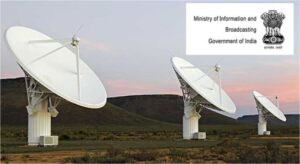
- Reliance is also placed on the Judgment of a three-judge Bench of the Supreme Court in Ministry of Information and Broadcasting, Government of India vs Cricket Association of Bengal, (1995) 2 SCC 161 (MIB vs CAB for short). Our attention is invited to Paragraphs 36, 43, 44, 47, 64, 78, 82, 174, 175 of the judgment.
Para 10.
- Learned Solicitor General, Addl Solicitor General, Senior Counsel/Counsels for the Respondents have strongly relied upon the Judgment of the three-Judge Bench of the Supreme Court in MIB Vs CAB, on which the Senior Counsel/Counsel for Petitioners also rely. They have also relied on some of the aforementioned judgments cited on behalf of the Petitioners and several other judgments contained in several compilations, most of which have been referred to by us hereinafter.
Para 12.
4. Television Broadcasting-Integral Part Of Article 19 (1) (a).
- It hardly needs any emphasis that the right to free speech and expression conferred by Article19(1)(a) is cherished and preferred and needs to be zealously guarded by Courts and is the most precious of all the freedoms guaranteed in our Constitution, as held by the Supreme Court. Freedom of speech and expression is thus of paramount significance under our constitutional scheme. Television broadcasting, with which we are concerned in the present case, being a medium of expression, inter alia for the citizens to express their views and creativity, is thus an integral part of Article 19(1)(a).Para 13.
- The aforesaid three-judge Bench decision of the Supreme Court (MIB vs CAB) has thus distinguished the judgments in Sakal Case Papers, Bennett Coleman, and Indian Express Newspapers, which dealt with print media and has summarised the law on the freedom of speech and expression under Article 19(1)(a) as restricted by Article 19(2) in relation to Broadcasting. The following propositions can be culled out from the Judgment of P. B. Sawant J (for himself and on behalf of Mohan J):
- (i) The freedom of the press includes the right to circulate and also determine the volume of such circulation. This fundamental right can be limited only by reasonable restrictions under a law on the eight grounds specified in Article 19(2).
- (ii) The right to impart and receive information is a species of the right of freedom and expression guaranteed under Article19(1)(a) of the Constitution. A citizen has a fundamental right to use the best means of imparting and receiving information and having access to telecasting for the purpose.
- (iii) When it comes to Broadcasting, a distinction has been made between print media. It has been held that electronic media is the most powerful media both because of the audio-visual impact and its widest reach covering sections of society where the print media does not reach. It has been further held that since airwaves are public property and are scarce, the airwaves have to be used to benefit society at large. They are required to be regulated in the interest of the public and to prevent invasion of their rights. This limitation imposed by the nature of the public property involved in the use of Broadcasting is in addition to the restrictions imposed on the right to freedom of speech and expression under Article 19(2) of the Constitution. In other words, when it comes to Broadcasting, the public interest would be an additional Limitation/restriction apart from the eight specified restrictions in Article 19(2).
- (iv) The Central Government was directed to take immediate steps to establish an authority to control and regulate the use of airwaves.
Para 15.
- In BSNL v. TRAI, (2014) 3 SCC 222, a three-Judge Bench of Supreme Court, on a reference, while dealing with the powers of TRAI under the TRAI Act, has held that the powers of TRAI to make Regulations under Section 36 is legislative in nature and that the said power is wide and pervasive.
Para 20.
- In Star India vs DIPP(2019) 2 SCC 104, the aforesaid Judgment of the three-judge Bench in BSNL vs TRAI has been followed by the Supreme Court. Paragraph 26 of the said Judgment stressed that a restrictive meaning cannot be given to the words “regulation” or “regulate” as otherwise the very object of the TRAI Act would be stultified.
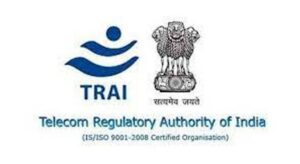
Para 21.
- In Hotel & Restaurant Assn. v. Star India (P) Ltd., (2006) 13 SCC753, the Supreme Court held:
- Para 55. TRAI exercises a broad jurisdiction. Its jurisdiction is to fix tariffs and lay down terms and conditions for providing services. Prima facie, it can fix norms and the mode and manner in which a consumer would get the services.
- Para 56. The role of a Regulator may be varied. A Regulation may provide for cost, supply of service on a non-discriminatory basis, the mode and manner of supply making provisions for fair competition providing for a level playing field, protection of consumers’ interest, prevention of monopoly. The services to be provided through the Cable Operators are also recognised. While making the Regulations, several factors are, thus, required to be taken into account. The interest of one of the players in the field would not be taken into consideration, throwing the interest of others to the wind.”
COMMENT: The High Court quoted three earlier judgments of BSNL v. TRAI, (2014) 3 SCC 222; Star India vs DIPP(2019) 2 SCC 104 and BSNL vs Trai (2014) 3 SCC 222 to hold that TRAI does have the power to fix tariffs and lay down terms and conditions for providing services to customers. It also held that the Ministry of Information and Broadcasting, Government of India vs Cricket Association of Bengal, (1995) 2 SCC 161 overruled the judgments relied upon Broadcasters, namely Sakal Case Papers (1962) 3 SCR 842, Bennett Coleman(1972) 2 SCC 788, and Indian Express News Papers1985 SCR (2) 287.
5. Primary Goal of Authority vs Public Interest
- Thus, the primary goal of the Authority is to regulate the telecommunication services and to protect the interests of service providers and consumers of the telecom sector, to promote and ensure orderly growth of the telecom sector and for matters connected therewith or incidental thereto as can be discerned from the Preamble of the TRAI Act. It can, therefore, hardly be disputed that price fixation of Television channels is a concomitant of the regulatory powers of TRAI and is conceived in the public interest.
Para 22.
- Undisputedly, the Broadcasters have a fundamental right to freedom of speech and expression, but the said right is not absolute. Telecasting by satellite involves the use of airwaves which is public property. The Judgment of the three-Judge Bench of Supreme Court in MIB vs CAB has distinguished the decisions in Sakal Papers, Bennett Coleman, and Indian Express Newspapers, which concerned print media. Since Broadcasting involves the use of airwaves which is public property, the public interest is an inbuilt restriction apart from the restrictions in Article 19(2). Those airwaves are required to be controlled and regulated in the public interest. They have to be used for the benefit of society at large. Regulation of telecom services in controlling the airwaves and protecting the interest of the public who own the airwaves may thus involve the imposition of reasonable restrictions, apart from the eight specified restrictions mentioned in Article19(2).
Para 23.
- To accept the contention of the Petitioners that Broadcasting Services cannot be regulated as that would infringe their right to free speech and expression under Article 19(1)(a) and that the interest of the public ought to be disregarded would be plainly contrary to what is held in the Judgment of the three-Judge Bench of the Supreme Court in MIB vs CAB. In the teeth of the said three-Judge Bench of the Supreme Court in MIB vs CAB, we do not see how it is really open for the Petitioners to contend that public interest cannot be taken into consideration in imposing any restrictions to the Petitioners’ right to freedom of speech and expression under Article 19(1)(a) of the Constitution or that Broadcasting Services cannot be regulated or that there can be no fixation of rates of Broadcasting Services under the Section 11(2) or for that matter any stipulations under Section 11(1)(b)(iv) of the TRAI Act which regulates sharing of revenue amongst service providers.
Para 23.
- As airwaves are public property, TRAI acts in a fiduciary capacity to ensure that the rights of consumers are also protected and to balance the rights of the consumers with the rights of the service providers/Broadcasters and to ensure orderly growth of the telecom sector as stated in the Preamble of the TRAI Act. Once it is held that the airwaves used by the Broadcasters are owned by the public, the public interest would perforce kick in. It cannot be kept out of consideration. The Broadcasters, therefore, would necessarily be required to be regulated in the public interest and to prevent the invasion of the rights of the public to freedom to be educated, informed, and entertained as held in MIB vs CAB. In our view, Broadcasters cannot be heard to say that they will use airwaves that are public property. Still, the interest of the public is disregarded. Hence, the entire edifice upon which the case of the Petitioners is founded, i.e., the restrictions can be confined only to the eight grounds specified in Article19(2) of the Constitution, would be effaced.
Para 27.
- The only aspect which can really be examined is whether in exercising the powers under Section 11(2)of the TRAI, the stipulations made vide the impugned Regulations/Tariff Orders would constitute ‘reasonable restrictions’ [which is the expression used in Articles 19(2)] and/or are manifestly arbitrary/arbitrary and therefore violate the fundamental rights of the Petitioners, which aspect we have dealt with in the latter part of this Judgment while dealing with the challenge to the impugned Principal 2017 provisions and impugned 2020
Para 27.
COMMENT: The High Court heavily relied on the Cricket Association of Bengal judgment of 1995 to hold that as airwaves are public property, TRAI had to act in “a fiduciary capacity to ensure that the rights of consumers are also protected and to balance the rights of the consumers with the rights of the service providers/Broadcasters and to ensure orderly growth of the telecom sector as stated in the Preamble of the TRAI Act.” In doing so, it held that this Judgment impliedly overruled the three judgments relied on by the Broadcasters-Sakal Papers, Bennett Coleman, and Indian Express Newspapers, which concerned print media.
If the Petitions are allowed to proceed by the Supreme Court, this is bound to be argued and tested by a Constitutional Bench.
6. Whether Rate Fixation Affects Article 19 (1) (a) Rights
- Undoubtedly, fixation of rates of channels may impact circulation. Ordinarily, circulation would be inversely proportional to the price of the channel. In other words, the higher the price, the lower would be the circulation and vice versa (this has been recognised in Sakal Papers also). In our view, however, even if price fixation or reasonable stipulations are prescribed by the Authority may affect circulation to some degree, that by itself would not be an infringement of the Broadcasters’ rights to freedom of speech and expression and the right of the Broadcasters would be required to be “balanced” with the rights the citizens to access television channels at reasonable rates.
Para 28.
- Moreover, in MIB vs CAB, it has been held that a citizen has a right that flows from the nature of the property involved, i.e., airwaves, which belong to the public. There would be a ‘limitation’ on the Broadcasters’ rights to freedom of speech and expression. There is, therefore, in our view, a need to strike a balance between the competing rights of Broadcasters and the rights of the citizens to access the television channels at reasonable rates as discussed herein below.
Para 30.
- Having regard to the principle of law laid in the aforesaid judgments, in our view, the fundamental rights of the Broadcasters cannot be considered in isolation, and a balance has to be struck between the competing rights of the Broadcasters vis-à-vis the rights of the citizens. In balancing such requests, the fact that there may be some curtailment of the rights of the Petitioners and/or a drop in the circulation/viewership to some degree would not be seen as an infringement of the fundamental rights of the Petitioners so long as the stipulations prescribed in such balancing are not unreasonable and are in the interest of the public. A fortiori, the Petitioners’ contention that the intention and direct effect of impugned Section 11 are to interfere with various facets of the right guaranteed under Article19(1)(a) including circulation, would be insubstantial.
Para 32.
- Ordinarily, the fundamental rights of the Broadcasters would have to yield to the public interest. However, the Parliament, in its wisdom, keeping in view the need for promotion and orderly growth of the telecom sector, has enacted the TRAI Act not only to protect the interests of the consumers but the service providers as well, as can be discerned from the Preamble of the TRAI Act. Thus, a level playing field would be required to be maintained between the rights of the Broadcasters and that of the public. The contention of the Petitioners that being an individual right under Article 19(1)(a) of the Constitution, there is no question of balancing interests, cannot be countenanced and is rejected.
Para 32.
- If the contentions of the Petitioners that there can be no price fixation or other stipulations including stipulations on the formation of bouquets as that would affect circulation is accepted, the entire purport and object for which the TRAI Act was enacted would be defeated.
Para 34.
- For the aforesaid reasons, we are unable to accept the contention of the Petitioners that Section 11 (so far as it relates to Broadcasting Services) violates their fundamental right to freedom of speech and expression under Article 19(1)(a) of the Constitution.
Para 35.
- On behalf of the Respondents, it is pointed out that if the challenge to Section 11(2) of the Petitioners is upheld, every single instance of tariff fixation by the TRAI for the last 17 years shall be liable to be struck down. It does appear that the present Petitions have been filed only after the impugned 2020 Amendments were to come into force by incorporating a challenge also to section 11, only as an afterthought.
Para 37.
COMMENT: This is the third serious effort by Broadcasters to escape the rigours of a regulated regime administered by TRAI starting from the challenge in Delhi High Court in CWP 24105/2005 decided against Star India and Sony by Delhi High Court order dated 09.07.2007 reported in 2007 SCC OnLine Del 951(SLP dismissed by SC) and the more recent 2018 judgment of Supreme Court in Star India Limited vs DIPP dated 30.10.2018 reported in 2019 2 SCC 104. The Bombay High Court explicitly held that if TRAI’s power under Section 11 (2) was struck down, it would, as argued by the respondents, lead to all instances of price fixation would be struck down. It held there is no violation of the Broadcaster’s fundamental right to freedom of speech and expression under Article 19 (1) (a) of the Constitution.
7. Whether Section 11 Affects Articles 19 (1) (g)/14/21 Rights
- Insofar as the challenge to Section 11 (in relation to Broadcasting services) on the ground of violation of the Petitioners’ rights under Articles 19(1)(g), 14 and 21 of the Constitution is concerned, it is contended on behalf of the Petitioners that the Broadcasters have a right under Article 19(1)(g) to manage their affairs in a profitable manner subject to reasonable restrictions provided under Article 19(6). It is contended that Section 11(2) allows commercial restrictions/constraints on TV channels which results in onerous obligation and would have a crippling effect on the business of the Petitioners, which would be a violation of the Petitioners’ right under Article 19(1)(g).
Para 38.
- It is further contended that considering the wide, untrammelled and unguided powers under Section 11(2), the section suffers from the vice of excessive delegation and arbitrariness under Article 14 of the Constitution. It is contended that the actions of TRAI would lead to a non-level playing field. Insofar as a violation of Article 21 is concerned, it is contended that the Section violates the right to livelihood of the Petitioners, which is an important facet of Article 21.
Para 38.
- Article 19(1)(g) guarantees the right to the citizens to carry on any occupation, trade, or business. However, this right is not absolute and is subject to reasonable restrictions under Article 19(6). It is required to be noted that Section 11 and Section 2(1)(k) of the TRAI Act were the subject matter of challenge before the Division Bench of Delhi High Court in Star India P. Ltd. v. TRAI, 2007 SCC OnLine Del 951, on the ground of violation of Articles 19(1)(a), 19(1)(g) and 14 of the Constitution, which challenge has been repelled by the Delhi High Court. The Petitioners therein had also challenged the Notification to include Broadcasting Services within the ambit of telecommunication services under the TRAI Act.
Para 39.
- Keeping in mind the law expounded in the aforesaid judgments coupled with the findings in the Judgment of the three-judge Bench of the Supreme Court MIB vs CAB, which inter alia holds that airwaves are public property and are required to be regulated in the public interest, as also the principle of balancing of rights as discussed by us above, and on a plain reading of the text of Section 11 (in relation to Broadcasting Services) we are of the view that challenge Section 11(2) and Section 11(1)(b)(iv) on the grounds of violation of Articles 14, 19(1)(g) and Article 21 lacks merit and cannot be accepted.
Para 44.
- There is nothing in the text of Section 11(2) per se, which can be said to be violative of the Petitioners’ rights under Article 14 or 21 of the Constitution. Nor does the text of Section 11(2), on a plain reading, impose any restriction on the Petitioners’ fundamental right to carry on a trade or Business enshrined in Article 19(1)(g) of the Constitution. Section 11(2) only seeks to regulate, and there is no prohibition on trade or business of the Petitioners. Public interest demands that the rates of the TV channels are fixed by the Authority in a manner that enables the consumers to access the TV channels at reasonable prices.
Para 45.
- We reiterate that Section 11(2) is an enabling section and cannot be invalidated only on account of a possibility of its abuse. Where there is abuse, what will be struck down is the abuse itself and not the provision.
Para 45.
- It is contended that Section 11(2) of the TRAI Act suffers from the vice of excessive delegation. Price fixation of TV channels under Section 11(2) may require monitoring and periodic revision. Prices may be dynamic and may fluctuate depending on market forces and other factors. Price fixation demands a considerable amount of expertise. Para 46.
- It may require prompt action to ensure that the interests of the service providers and consumers are protected so that a level playing field is maintained. It is, therefore, imperative that an expert Regulatory body (TRAI in the present case) exercises this function and plays the role of a market regulator for the telecom sector in an effective manner. Para 46.
- Once we have upheld the validity of Section 11 (so far as it relates to Broadcasting Services) of the TRAI Act, there is no question of reading down the said provision.
Para 49.
- In light of the above discussion, we find no merit in the contention of the Petitioners that Section 11 (so far as it relates to Broadcasting Services) of the TRAI Act impinges their fundamental rights guaranteed under Articles 14, 19(1)(a), 19(1)(g), and 21 of the Constitution. The challenge to the validity of Section 11 of the TRAI Act, therefore, fails.
Para 50.
COMMENT: The main ground of rejection by the High Court is that the Broadcaster argument that Section 11 (2) of the TRAI Act does not impose any restriction on the Petitioner’s fundamental right to continue trade or business under Article 19 (1) (g). It has relied on the test of public interest to hold that price fixation under Section 11 (2) is not violative of Petitioners fundamental right to conduct business under Article 19 (1) (g).It rejected the alternate plea of reading down the provision to limit its applicability to the carriage (distribution) sector.
8. The Challenge To The Principal 2017 Regulations And Principal 2017 Tariff Order (Paras 51-62).
- The Petitioners contend that the impugned Principal 2017 Regulations and impugned Principal 2017 Tariff Order violate their fundamental rights under Article 14, 19(1)(a), 19(g) and 21 of the Constitution.
Para 52.
- The provisions of the Principal 2017 Regulations and Principal 2017 Tariff Orders were the subject matter of challenge before the Madras High Court in Civil Writ Petition 44126/44127 of 2016 dated23.03.2018. Aggrieved by the majority decision of the Madras High Court, an SLP was preferred before the Supreme Court. The Supreme Court rendered its Judgment on October 30, 2018, authored by his Lordship Justice Nariman on behalf of the Bench, reported in Star India Private Ltd. vs Departmental Industrial Policy and Promotion and Ors., (2019) 2 SCC 104 (Star India vs DIPP).
Para 53.
The (key) findings of the Supreme Court in the aforesaid Judgment of Star India vs DIPP, while dealing with the challenge to that impugned Principal 2017Regulations and impugned Principal 2017 Tariff Order, can be culled out asunder:
(i) Under Section 36 of the TRAI Act, the Authority is empowered to conduct the purposes of the said Act, as can be discerned from the Preamble to the Act. What is clear from the amended Preamble to the Act is that the interests of service providers and consumers are of paramount importance, both of which have a role to play when Regulations are framed under Section 36.
(ii). The TRAI Act has to be viewed in light of protecting the interests of both service providers and consumers. No constricted meaning can be given to the provisions of the TRAI Act.
(iv). At no stage is the content of a TV channel sought to be regulated.
(v.)Pricing relating to TV channels laid down in the Regulation and Tariff Order is a balancing act between the rights of Broadcasters and the interests of consumers.
(vii). The Explanatory Memorandum shows that the focus of the Authority has always been the provision of a level playing field to both the Broadcaster and the subscriber.
(viii). When high discounts are offered for bouquets that are provided by the Broadcasters, the effect is that subscribers are forced to take bouquets only, as the à-la-carte rates of the pay channels found in these bouquets are much higher. This results in the perverse pricing of bouquets vis-à-vis individual pay channels. In the process, the public ends up paying for unwanted channels, thereby blocking newer and better TV channels and restricting subscribers’ choice. It is for this reason that discounts are capped. While doing so, however, full flexibility has been given to Broadcasters to declare the prices of their pay channels on an à-la-carte basis.
(ix). The Authority has shown that it does not encroach upon the freedom of Broadcasters to arrange their business as they choose. Also, when such discounts are limited, a subscriber can then be free to choose à-la-carte channels of his choice. It is only efforts aimed at thwarting competition and reducing à-la-carte choices that are, therefore, being interfered with.
(x). To maintain the balance between the subscribers’ interests and Broadcasters’ interests, again the Authority makes it clear that Broadcasters have complete freedom to price channels that do not form part of any bouquet and are offered only on an à-la-carte basis.
(xi). The Regulations and the Tariff Order have been made, keeping the interests of the stakeholders and the consumers in mind and are Intra vires the regulation power contained in Section 36 of the TRAI Act.
(xii). The Broadcaster is free to provide whatever content he chooses for the TV channels that he chooses to transmit to the ultimate consumer. The Broadcaster is free to arrange the price of his TV channels so long as they are non-discriminatory and do not otherwise have the effect of unreasonably restricting a subscriber’s choice to choose a bouquet or à-la-carte channels.
- In our view, the aforesaid Judgment of the Supreme Court says it all and to a large extent forecloses the case of the Petitioners except the ground of violation of the fundamental right of free speech and expression under Article 19(1)(a). In light of aforesaid findings of the Supreme Court extracted above, it is impossible to accept the contentions on behalf of the Petitioners that the stipulations in the impugned Principal 2017 Regulations and impugned 2017 Tariff Order are unreasonable or manifestly arbitrary and that the Petitioners’ fundamental rights under Article 14 and 19(1)(g) and 21 of the Constitution are infringed. The stipulations prescribed are reasonable restrictions within the meaning of Article 19(6) of the Constitution.
Para 56.
- For the reasons mentioned above and the reasons mentioned in the earlier part of this Judgment, while dealing with a challenge to Section 11 of the TRAI Act, we are unable to accept the contentions of the Petitioners that their fundamental rights under Article 19(1)(a) of the Constitution are infringed by the impugned Principal 2017 Regulations and Principal 2017Tariff Order. In our view, the stipulations prescribed by the impugned Principal 2017Regulations and impugned Principal 2017 Tariff Order are reasonable restrictions within the meaning of Article 19(2) of the Constitution. The Authority has maintained a level playing field between the Broadcasters and consumers, as held by the Supreme Court in Star India vs DIPP, while dealing with the challenge to the provisions of the impugned Principal 2017 Regulations and impugned Principal 2017 Tariff Order.
Para 59.
- In the circumstances, it is not possible to accept the contention of the Petitioners that their fundamental rights under Article 19(1)(a) are infringed by the impugned Principal 2017 Regulations and impugned Principal 2017 Tariff Order. Even otherwise, for the reasons mentioned, we are steadfast in our view that the aforesaid clauses also are reasonable and do not impinge upon any of the fundamental rights of the Petitioners.
Para 61.
- In light of the aforesaid discussions, the challenge to the validity of the Principal 2017 Regulations and Principal 2017 Tariff Order on the ground that they violate the Petitioners’ fundamental rights under Article 14, 19(1)(a), 19(1)(g), and 21 of the Constitution also fail.
Para 62.
COMMENTS: The High Court held that the October 2018 Supreme Court judgment forecloses all arguments of the Broadcasters except the ground of violation of the fundamental right of free speech and expression under Article 19(1)(a). It held that the Authority has maintained a level playing field between the Broadcasters and consumers, as held by the Supreme Court in Star India vs DIPP, while dealing with the challenge to the provisions of the impugned Principal 2017 Regulations and impugned Principal 2017 Tariff Order. In addition, the High Court independently held that the impugned clauses also are reasonable and do not impinge upon any of the fundamental rights of the Petitioners.
Para 61.
9. Challenge To The 2020 Regulations Amendment And 2020 Tariff Order Amendment (Paras 63-101).
- The Petitioners in all the Petitions have impugned the 2020Regulations Amendments and 2020 Tariff Order Amendment (impugned
2020 Amendments) on the ground that they infringe their fundamental rights under Article 19(1)(a), 19(1)(g), 14 and 21 of the Constitution.
Para 64.
- Only when the impugned 2020 Amendments were to be rolled out, the Petitioners filed the present Writ Petitions in February 2020, seeking to challenge the validity of the 2020 Amendments and the validity of Section 11 well as the Principal 2017 The Petitioners, therefore, are primarily aggrieved by the 2020 Amendments.
Para 65.
- The Petitioners assail the underlined portion of Clause 3 of the 2020Tariff Order Amendment reproduced above, and the arguments advanced before us are on the following four issues:
Issue I
If the à-la-carte price of a channel is more than Rs.12/-(which was earlier Rs. 19/-), the channel could not be included in a bouquet.
Issue II
The sum of maximum retail prices per month of the à-la-carte-channels forming part of bouquet shall in no case exceed one and half times the maximum retail price per month of such bouquet(i.e., “Aggregate Test”– 2nd twin condition – in mathematical terms, this means bouquets can be priced at a maximum of 33.33%discount qua the sum of à-la-carte prices of channels in the bouquet).
Issue III
The maximum retail price per month of anyone à-la-carte pay channel forming part of such a bouquet shall in no case exceed three times the average maximum price per month of a pay channel of that bouquet (i.e., “Average Test”– 2nd twin condition).
Issue IV
The number of bouquets of pay channels offered by a Broadcaster shall not exceed the number of à-la-carte pay channels offered by such Broadcaster.
Issues II and III are ‘the twin conditions.
Para 69.
Petitioners’ arguments on Issues I to IV.
- The Petitioners made a series of arguments citing case law which are summarised in twenty-four sub paras. Key arguments are extracted below:
- i) While Regulations may be delegated legislation, a Tariff Order is only an “administrative order” and does not enjoy protection under the law like a delegated legislation.
- (iii) The impugned 2020 Amendments violate the Petitioners ‘fundamental rights under Articles 14, 19(1)(a) & 19(1)(g) and 21of the Constitution.
- (iv) The reduction in the price cap on the maximum retail price of pay channels from 19/- to Rs.12/- for being eligible for inclusion in Broadcasters’ bouquets are manifestly arbitrary and unreasonable.
- (v) The introduction of 5x (Aggregate Test) and 3x (Average Test)price stipulation (twin conditions) in respect of pricing of à-la-carte pay channels of bouquet comprising such channels are manifestly arbitrary and unreasonable.
- (vi) The introduction of a limit on the number of bouquets offered is manifestly arbitrary and unreasonable.
- (vii) The price cap and the twin conditions were not proposed in the Consultative Papers. No reasons were provided for introducing the said stipulation. The twin conditions have, through the backdoor, reintroduced the cap on discounts on bouquets and restricted such discounts to 33%. The twin conditions existed in the pre-2017 regime and only existed at the wholesale level. There is no rationale for introducing the twin conditions.
- (viii) The twin conditions were reintroduced despite the fact that it was abandoned by 2017 The twin conditions were introduced despite there being no change in the market conditions and ignoring the fact that overwhelming preference by consumers is for bouquets over à-la-carte channels.
- (ix) The reduction in a price cap on MRP of pay channels for inclusion in the bouquet from 19/- to Rs.12/- was done without any study/empirical exercise. No explanation or reasons are given for arriving at a cap of Rs.12/-.
- (xii) The impugned 2020 Amendments are a product of premature and hasty exercise. The Explanatory Memorandum of the Principal 2017Tariff Order stated that the Authority will keep watch on the developments in the market on account of the new regulating regime for 2 years before undertaking any review.
- (xiv) It is an admitted position that 2/3rd of the Broadcasters’ revenues come from advertisements. That is the reason the subscriber rates in India are amongst the cheapest globally. In the present highly competitive market, if the Broadcasters cannot increase the prices of the channels to make up for the loss of revenue, it would compromise the quality.
- (xv) If the bouquets are curtailed in the manner proposed by the TRAI, cross-subsidisation of channels will not be possible. The Broadcasters will be forced to depend on subscription revenue, thereby increasing the burden on the consumers.
- (xvi) Section 11(4) of the TRAI Act requires that the exercise of Regulatory jurisdiction by the TRAI should be This phrase “transparent” over a period of time has been interpreted to mean that there should be a consultation process and that it should be transparent. The introduction of twin conditions by TRAI without conducting the mandatory exercise of the consultation process exhibit a lack of transparency.
- (xviii) The TRAI is attempting to micro-manage the affairs of the Broadcasters. They are in contrast to the continued emphasis of the Government of India on the ease of doing business. Reliance is placed on the Judgment of the Supreme Court in Reliance Energy Ltd. Vs MSRDC, (2007) 8 SCC 1.
- (xxiv) DPO is the face between the Broadcaster and the customer. Virtually 95% of subscribers avail of bouquets offered by DPOs as opposed to just 5% who avail of Broadcaster bouquets. Yet, TRAI has applied the twin conditions only to bouquets offered by Broadcasters and not to bouquets of DPOs. This manifest fallacy in the 2020Tariff Order and Regulations does not achieve the alleged objective of TRAI since consumers will not get the benefit of these twin conditions on bouquets offered by DPOs.
Para 71.
10. Parameters of Judicial Review
- It would be first necessary to discuss the parameters of judicial review and deal with the contention of the Petitioners that a Tariff Order is only an administrative order and not “law” within the meaning of Articles 19(2)&19(6) of the Constitution. Consequently, no restrictions can be imposed on the exercise of the fundamental rights guaranteed by Articles 19(1)(a) & 19(1)(g) of the Constitution.
Para 73.
- Applying the tests laid down by the aforesaid judgments in the present case, it is impossible to accept the contention on behalf of the Petitioners that a Tariff Order, which is a price fixation and a regulatory exercise the Authority, is only an administrative order. In BSNL vs TRAI, the three-Judge Bench of the Supreme Court has held that the powers of TRAI to make Regulations under Section 36 is legislative in nature and that the said power is wide and pervasive.
Para 74.
- In Star India vs DIPP, the Supreme Court has held that the Principal 2017 Regulations and 2017Tariff Order are intra-vires to the regulatory power contained in Section 36 of the TRAI Act. A Tariff Order issued after a consultation process thus falls within the regulatory power contained in Section 36 of the TRAI Act. In view of the above, the contention of the Petitioners that a Tariff Order is not law within the meaning of Article 19(2) and Article 19(6) of the Constitution, and therefore no restrictions can be imposed by a Tariff Order which affects the fundamental rights of the Petitioners under Article 19(1)(a). Article 19(1)(g) cannot be accepted and is accordingly rejected.
Para 74.
Comment: This issue was fundamental to the Broadcaster Appeals in 2005 and now in 2020. The Delhi High Court in CWP 24105/2005 dated 09.07.2007 held that the power of TRAI under Section 11 (2) is valid and further observed
- Para 38. Therefore, there can be no gainsaying that the individual recipient has the greatest and most significant and meaningful right under Article 19(1)(a). This aspect of free speech is at the fulcrum of every decision of the Hon’ble Supreme Court. In Sakal, their Lordships were of the view that the existing readership of the newspaper would be adversely affected. We are unable to agree with learned Senior counsel for the Petitioners that if the tariff of pay channels is regulated by the Authority, the inexorable and inevitable effect would be that the Petitioners will be run out of business. The Petitioners have not been forthright in presenting even the break-up between advertisement earnings and collection from subscriptions. In this respect, they are playing fast and loose by alternating stating in different proceedings that 70 per cent of their receipts are from subscriptions and 30 per cent from advertisements and vice versa. We would believe that advertisement revenue constitutes 70 per cent of Broadcasters earnings, with the logical consequence that any increase in viewership leads to a corresponding increase in advertising rates.
In the present Judgment, the High Court held that the contention of the Petitioners that a Tariff Order is not law within the meaning of Article 19(2) and Article 19(6) of the Constitution, and therefore no restrictions can be imposed by a Tariff Order which affects the fundamental rights of the Petitioners under Article 19(1)(a). Article 19(1)(g) cannot be accepted and is accordingly rejected. Para 74.
11. The Four Challenges To The 2020 Tariff Order
The issue I – Cap Of Rs.12/- On Any Channel To Be Included In A Bouquet,
- The Authority has stated that the bouquet should be formed by bundling channels that are affordable and are in similar price brackets, and if high-value channels are allowed to be part of the bouquets, the basic objective of the framework that the niche channel should only be given to the consumer on his free will, will be defeated. There simply cannot be any mathematical precision on the ideal cap for a channel to form part of a bouquet. Enough elbow room or play in the joints is required to be given to the Authority in price-fixation. The Court cannot substitute its opinion with that of an expert body like TRAI. It needs to be emphasised that the cap of 12/- is only on a channel that forms part of a bouquet. The Authority has chosen not to place any cap on the MRP of à-la-carte channels, which do not form part of a bouquet. Thus, the reduction in the ceiling from Rs.19/- to Rs.12/-, for a channel to be included in a bouquet, in our view, cannot be said to be arbitrary or unreasonable
Para 77.
Issue II – 1st twin condition (Aggregate test)– a cap on discount of 33.33% on the sum of à-la-carte prices of channels which can be offered on bouquets
- The Authority found that the popular channels are priced at MRP of 19/- to qualify to be part of a bouquet and then bundled with mostly low priced and less demanded channels. By adopting this business model, the Broadcasters maximise their reach even for not so popular channels, which increases their subscription revenues. The consumers end up subscribing to channels not of their own choice, but as a compulsion and even paying for those channels which they are not inclined to watch, which in effect, results in an increase in their monthly payment for subscription of TV channels, apart from losing out on choice with free will. The Authority has displayed figures in the form of tables and charts to demonstrate that the Broadcasters are tactfully forming their bouquets which comprise many low priced but less popular channels and very few high priced but popular channels. Thus, channels having a wide variation in their à-la-carte prices are being clubbed together in a bouquet resulting in illusory pricing of pay channels to subscribers.
Para 78
- The Authority has observed that the consumers’ right to choose is paramount. As a body mandated by statute, TRAI cannot allow a situation where a business practice takes precedence over that right. The Authority has noted that for addressing the consumer concern, the possible option could be
- (i)to regulate or cap à-la-carte prices of channels; or
- (ii) to place reasonable restrictions on the formation of bouquets, without affecting the flexibility of the market players, either on the pricing of channels or packaging in bouquets.
Para 78.
- We reiterate and independently find that the manner in which bouquets are being pushed by manipulating the prices of the à-la-carte channels results in perverse pricing and deprive the subscribers of making an informed and real choice. The Authority has only stipulated the maximum discount given by the Broadcasters qua the sum of the a-la-carte prices of the channels in a bouquet. The autonomy of the Broadcasters has not been taken away, and the Authority has only sought to protect the interest of the consumers. Hence, it cannot be said that the cap on discount of 33.33% on the sum of à-la-carte prices of channels that form a bouquet (1st twin condition – Aggregate Test) is unreasonable or arbitrary.
Para 82.
Issue IV– Cap on the number of bouquets not exceeding the number of à-la-carte channels offered by the Broadcasters.
- The Authority has set out Figure 3, which shows the number of à-la-carte pay channels and bouquets of channels offered by major Broadcasters, including their group companies. The Authority has noted that the major Broadcasters have declared 97, 86, 26, 93 and 29 bouquets while the number of pays channels offered is 57, 59, 33, 74 and The Authority has stated that it would be evident from these figures that the number of the bouquets provided by Broadcasters is very large. Such offerings are bound to create confusion in the mind of consumers. It will be difficult for any consumer to make an informed and prudent choice from many bouquets and à-la-carte channels. The Authority has noted that there are already around 900 à-la-carte channels. It has been stated that many bouquets cause an unnecessary burden on the IT and billing systems of the DPOs.
Para 83.
- The Authority has noted that the formation of bouquets is nothing but bundling of a number of channels together and offering value for money for the consumers. Therefore, it does not make much sense if the number of bouquets of pay channels offered by the Broadcaster exceeds the number of pay channels offered by a Broadcaster.
Para 83.
- On perusal of paragraphs 62 to 71 of the Explanatory Memorandum, it is noted that the Authority has analysed the data and considered the comments of the stakeholders and has applied its mind and given cogent reasons. We find that the Authority has prescribed the cap on the number of bouquets in the interest of the consumers and to avoid creating confusion in their minds in choosing from many bouquets and avoiding unnecessary burden on the IT and billing system of the DPO. It is required to be noted that the cap prescribed is on the number of‘ bouquets’ only. We are of the view that capping the number of bouquets by the Authority cannot be said to be unreasonable or arbitrary.
Para 84.
- Thus, the heart of the matter is ‘bouquets’ formed by the Broadcasters. The stipulations prescribed vide the aforesaid three Issues viz. Issues I, II and IV, are reasonable and cannot be said to be arbitrary, as indicated above.
Para 85.
- It needs to be borne in mind that we are examining the challenge to the 2020 Amendments only on the touchstone of the violation of the fundamental rights of the Petitioners and the parameters of judicial review as discussed earlier. So long as a stipulation in the impugned 2020 Tariff Order Amendment is in the zone of reasonableness, it is not for this Court to sit in appeal over the decision of the TRAI, which is an expert body and to substitute the said decision. Reasonableness has to be also examined from the standpoint of interest of the public to carry out the object and purposes of the TRAI Act. We are satisfied that the stipulation prescribed by the impugned 2020Amendments only balances the public’s interest with that of the Broadcasters and maintains a level playing field that the Authority as the regulator is duty-bound to do. Para 86.
COMMENT: The High Court has gone by the test of “public interest” in upholding Issues I, II and IV. Perhaps, in view of this writer, the issues raised by TRAI could have been resolved by dialogue among various sections of Service Providers. Anyway, now the matter will get finally settled by Supreme Court in a couple of weeks.
12. Violation Of Free Speech And Expression Under Article 19 (1) (a)
- We now come to the contention of the Petitioners that the 2020 Tariff Order Amendment violates their fundamental rights of free speech and expression under Section 19(1)(a) of the Constitution. It is submitted that the implementation of the impugned 2020 Amendments would result in a drop in circulation/viewership of channels, thereby narrow the dissemination of information and infringe their fundamental right u/s. 19(1)(a). First and foremost, it needs to be noted that the 2020 Amendments are yet to be implemented by the Petitioners. One cannot entirely rule out the possibility of an increase in circulation/viewership and more so if the Petitioners choose to price their popular à-la-carte channels at Rs. 12/- (or less), which was hitherto Rs. 19/- to include such channel in a bouquet. Moreover, the 2020 Amendments relate to the formation of bouquets only.
Para 92.
- Even assuming there is some drop in the circulation apprehended by the Petitioners on account of the stipulations prescribed in the impugned 2020 Tariff Order including the stipulations on bundling of channels/formation of bouquets, the said stipulations are, in our view, in the interest of public and seek to remedy the bouquets mischief and cannot be said to be unreasonable or arbitrary. The stipulations prescribed are part of the regulatory exercise by the Authority of balancing the interest of the consumers with that of the Broadcasters and to achieve a level playing field.
Para 92.
- In the light of the aforesaid discussion, it is not possible to accept the case of the Petitioners that the impugned 2020 Amendments violate the Petitioners’ fundamental rights guaranteed under Articles 14, 19(1)(g) and 21 of the Constitution. The stipulations prescribed by the aforesaid three issues viz. Issues I, II and IV would constitute reasonable restrictions within the meaning of Article 19(6) and cannot be said to be arbitrary.
Para 91.
- For the reasons mentioned above and the reasons mentioned in the earlier part of this Judgment, while dealing with a challenge to Section 11 of the TRAI Act, we are unable to accept the contention of the Petitioners that their fundamental rights under Article 19(1)(a) of the Constitution are infringed. In our view, the stipulations prescribed by the impugned 2020 Tariff Order Amendment would constitute reasonable restrictions within the meaning of Article 19(2) of the Constitution.
Para 93.
We reiterate that the aforesaid discussion only relates to Issues I, II and IV. So far as Issue III is concerned, we have dealt with the same herein below.
Para 94.
Comments; The High Court has rejected the broadcasters’ argument that the new amendments would lead to a drop in the viewership and countered it by saying that dropping the a la carte rate to Rs. 12 may actually increase viewership.
Issue III – (2nd twin condition – Average test) – Cap on the price of the channel that can be offered in a bouquet with reference to the average price of the other pay channels included in the bouquet
- Having per used the Consultation Paper dated August 16, 2019, for the 2020TariffOrderAmendment,wefindthattheaforesaidIssueIII,i.e.,the2ndtwincondition (Average Test),did not form part of the Consultation Paper fails the test of transparency. The second twin condition (Average Test) was not proposed for the principal 2017 Tariff Order consultation. It was non-existent in the thePrincipal2017 Tariff Order. However, the 1st twin condition (Aggregate Test with 15% discount) in the Principal 2017 Tariff Order was arbitrary and unenforceable by the Madras High Court and the Supreme Court in Star India vs DIPP did not interfere with that finding.
Para 96.
- Thus, while eliciting comments on the cap on discount on the sum of à-la-carte channels forming part of the bouquet, i.e., the 1st twin condition(Aggregate Test) proposed for consultation, the Authority has categorically used the expression “whether there is a need to reintroduce….” However, we find that there is no question posed in the Consultation Paper for the 2020 Tariff Order Amendment seeking comments on the 2nd twin condition (Average Test). The twin conditions are not something new. Para 97.
- The Judgment of the Supreme Court in COAI vs TRAI discussed in Paragraph 89 above supports the case of the Petitioners on the issue of transparency. As far as the Judgment of the Delhi High Court in Syniverse Technologies (India) Pvt. Ltd. vs TRAI dated 03.05.2019 discussed in Paragraph 90 above is concerned, though this was a case of draft Regulations, it supports the case of the Petitioners on the issue of transparency since, in the present case also, the 2nd twin condition (Average Test) was not proposed for eliciting responses for consultation in the Consultation Paper for the impugned 2020 Tariff Order Amendment.
Para 99.
- We, therefore, hold that 2nd twin condition (Average Test) contained in the proviso to clause (3)(b) of the 2020 Tariff Order Amendment viz- the maximum retail price per month of any à-la-carte pay channel, forming part of such a bouquet, shall in no case exceed three times the average the maximum price per month of a pay channel of that bouquet – is manifestly arbitrary and infringes the Petitioners’ fundamental rights under Article 14 of the Constitution. The 2nd twin condition (Average Test) contradictsClause11(4) of the TRAI Act, which mandates the Authority to ensure transparency. It is liable to be set aside and accordingly set aside. The fact that the said 2nd twin condition (Average Test) was not proposed by the Authority even in the Principal 2017 Tariff Order shows that the 2nd Twin condition (Average Test) is severable from the rest of the provisions of the impugned 2020 Tariff Order Amendment.
Para 100.
- For the foregoing reasons, we hold that the 2020 Amendments do not violate the Petitioners’ fundamental rights under Article 14, 19(1)(a), 19(1)(g) and 21 of the Constitution except to the extent that the 2nd Twin Condition (Average Test) contained in the proviso to Clause (3)(b) of the impugned 2020 Tariff Order Amendment, which is arbitrary being contrary to the mandate of section 11(4) of the TRAI Act of ensuring transparency and violates the Petitioners’ fundamental rights under Articles 14 of the Constitution.
Para 101.
Comment: The High Court has struck down Issue III (second twin condition) on the ground of violation of transparency criteria under Section 11 (4) of the TRAI Act. It has not gone into the merits of the second twin condition.

13.Whether the DPOs are not being regulated in forming their own Bouquets (Paras 102-105)
- It is contended on behalf of the Petitioners that the restrictions of ‘twin conditions’ and 12/– on Broadcasters are imposed only on the Broadcasters. No such restrictions are imposed on the DPOs who can form their own bouquet, and the DPOs are left unregulated. It is submitted that since 94.6% of the consumer viewership is DPO bouquets, the consumers do not benefit from the twin conditions on bouquets offered by DPOs, which is discriminatory. We are afraid it is not possible to accept this contention.
Para 102.
- Broadcasters supply feed to DPOs, and DPOs provide the infrastructure to carry the feed to the consumer. The DPO is paid by consumers for providing such infrastructure, a Network capacity fee regulated by TRAI. The DPO also gets a Distribution Fee from Broadcasters, which is also regulated by TRAI. The offering by the Broadcasters to DPOs is of two types –
- ‘A-la-carte’ channels, and
- Broadcaster bouquets (this is the “MRP”).
The DPOs have no role in fixing the MRP. The DPOs are mandated to make available all Broadcaster offerings (whether à-la-carte channel or Broadcaster bouquets) in respect of all Broadcasters with whom a Reference Interconnect Offering (RIO) has been signed. The DPOs cannot make these available above the Broadcaster declared MRP, as mandated by the proviso to Clause 4(3) of the Principal 2017Tariff Order.
Para 103
- The DPOs can make their own bouquets called DPO bouquets, and their price is the ‘DRP’(Distributor Retail Price). The building blocks for DPO bouquets are
- i) an à-la-carte channel of one or more Broadcasters, and
- ii) Broadcaster bouquets of one or more Broadcasters. The DPO may decide what composition of the DPO bouquet should be based on consumer preference. When the DPOs make their own bouquets, the pricing of such bouquets (DPO Bouquets) is also regulated by TRAI, which imposes on them the following two conditions [see proviso to Clause 4(4) of the Principal2017 Tariff Order]:
- (a) The bouquet will not consist of a channel whose MRP is more than 12/-(This is the same condition that applies to Broadcaster bouquets under the 2020 Tariff Order Amendment).and
- (b)The DRP of the DPO bouquet cannot be less than 85% of the total of DRPs of its constituents. In other words, the DPO cannot offer a discount of more than 15%. This is a far more stringent requirement than 33.33% (as in the case of Broadcasters). The 15%cap on the discount comes into play only after the trickledown effect of the conditions imposed on the Broadcasters. Though it is contended by the Broadcasters that 94.6% of the consumer viewership is DPO bouquets, they have not disclosed that the bulk of the DPO bouquets that the consumers subscribe to include Broadcaster bouquets.
Para 104.
- Learned Senior Counsel for the TRAI has pointed out a Table annexed as Tab 11 to the Written Submissions on behalf of TRAI, which is an illustrative data giving detailed break-up for November 2019 of top ten pay channels, which shows that the bulk of the DPO bouquets include the Broadcaster bouquets and constitute overwhelming part of consumer viewership, e.g., Serial no.1 of the Table shows in the case of Star India Pvt. Ltd., while the percentage of DPO bouquets made from Broadcasters bouquets was90%, the percentage of DPO bouquets made dehors Broadcaster bouquets were only 0.36%. It is pointed out on behalf of the Respondents that in addition, 14.30%of consumers opted for Broadcaster bouquets directly. This would show that there is very little scope left for DPO to form truly customised DPO bouquets. Thus, Clause 4(3) and Clause 4(4) of the Principal 2017 Tariff Order impose sufficient conditions on the DPOs offerings of bouquets. It cannot be said that the DPOs offerings of bouquets are left unregulated. There is no discrimination between the Broadcasters’ bouquets and DPO bouquets.
- Pertinently, the Petitioners have not argued or placed anything on record to counter the aforesaid facts and submissions. The discussion above has also to be viewed in the backdrop that we have already held that the 2nd twin condition(Average Test) of the 2020 Tariff Order is arbitrary and have set aside the said condition, which would not be enforceable against the Broadcasters. In the circumstances, the contention that the DPOs are left unregulated and that the Broadcasters are being discriminated against cannot be accepted.
Para 105
COMMENT: The High Court has relied on data supplied by TRAI in the form of a Table, which show most DPO bouquets are Broadcaster bouquets. Hence it rejected this argument of Broadcasters of discrimination in favour of DPOs.
14.Summary of Judgment-Upshot (Para 106/107)
- The upshot of the above discussion is as under:
- The challenge to the constitutional validity of Section 11 of the Telecom Regulatory Authority of India Act, 1997 (so far as it relates to Broadcasting Services) fails.
- The challenge to the constitutional validity of the Telecommunication(Broadcasting and Cable) Services Interconnections (Addressable Systems) Regulations, 2017, Telecommunication (Broadcasting and Cable) Standard of Quality of Service and Consumer Protection (Addressable Systems) Regulations 2017 (hereinafter referred to as “Principal 2017 Regulations”) and the Telecommunication (Broadcasting and Cable) Services (Eighth) (Addressable Systems) Tariff Order, 2017,
- The challenge to the constitutional validity of the Telecommunication(Broadcasting and Cable) Services Interconnections (Addressable Systems)(Second Amendment) Regulations, 2020, Telecommunication (Broadcasting and Cable) Standard of Quality of Service and Consumer Protection (Addressable Systems) (Third Amendment) Regulations 2020 and the Telecommunication(Broadcasting and Cable) Services (Eighth) (Addressable Systems)Tariff (Second Amendment) Order, 2020, fails, except to the extent stated hereinafter.
- It is held that 2nd twin condition (Average Test)contained in the proviso to Clause (3)(b) of The Telecommunication(Broadcasting and Cable) Services (Eighth) (Addressable Systems)Tariff (Second Amendment) Order, 2020 is arbitrary, being contrary to the mandate of Section 11(4) of the TRAI Act of ensuring transparency and violates the Petitioners’ fundamental rights under Article 14 of the Constitution.
CONCLUSION:
As stated earlier, this is the third serious effort to block TRAI’s power to fix rates, issue terms and conditions for the provision of Cable TV services, and create a level playing field amongst service providers, keeping customer interest paramount. Though the initial hearing in the Supreme Court did not result in a stay of the NTO:2 Judgment, the reluctance to implement the January 1, 2020 Regulation now after 18 months does not augur well for an industry that serves over 100 million homes.
The lockdown has led to confirmed cord-cutting quite substantially. This writer has consistently pressed for dialogue with the Government and the Regulator, keeping sectarian interests aside. It has not happened in the past 20 years and is unlikely even today. We will now have to await the hearing on August 18,2021, in the Supreme Court.
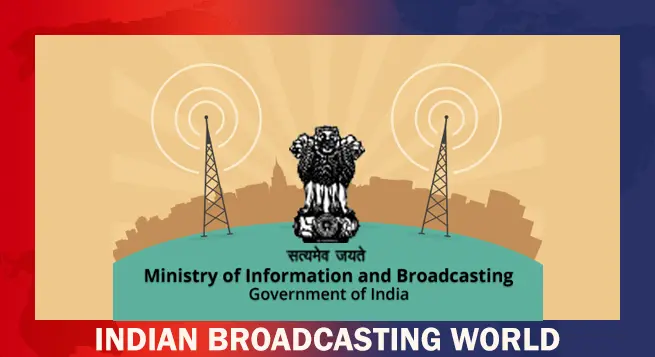 New draft of B’cast Bill proposes to regulate news influencers
New draft of B’cast Bill proposes to regulate news influencers 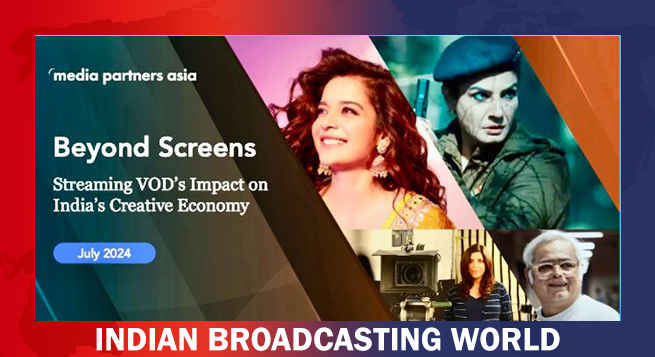 Premium online video to fuel 50% new revenue growth in India: MPA report
Premium online video to fuel 50% new revenue growth in India: MPA report  Top performer India’s 2024-29 ad revenue to grow@9.0%: MPA
Top performer India’s 2024-29 ad revenue to grow@9.0%: MPA 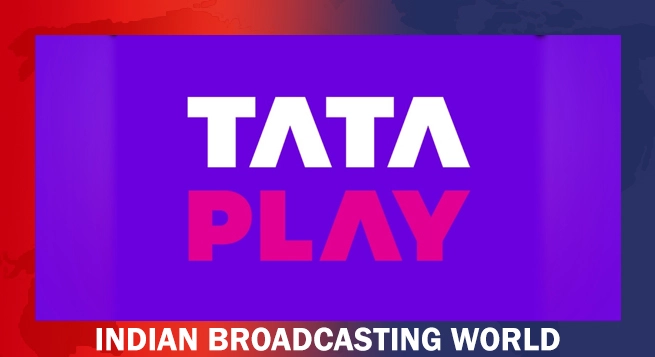 Tata Play’s revenue dips 4.3% to Rs 4,304.6 cr in FY24
Tata Play’s revenue dips 4.3% to Rs 4,304.6 cr in FY24  General Anil Chauhan joins News9 to honour 25 years of Kargil victory
General Anil Chauhan joins News9 to honour 25 years of Kargil victory 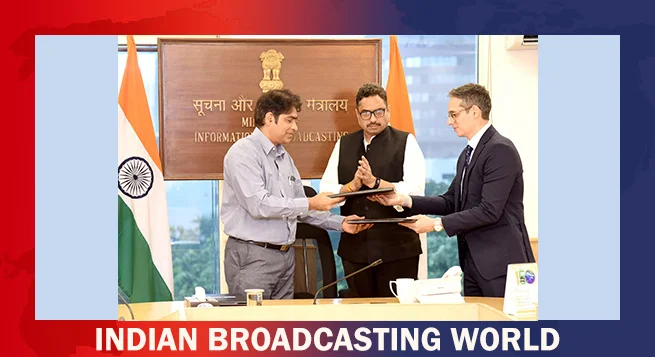 NFDC, Netflix partner to upskill voice-over artists in India
NFDC, Netflix partner to upskill voice-over artists in India 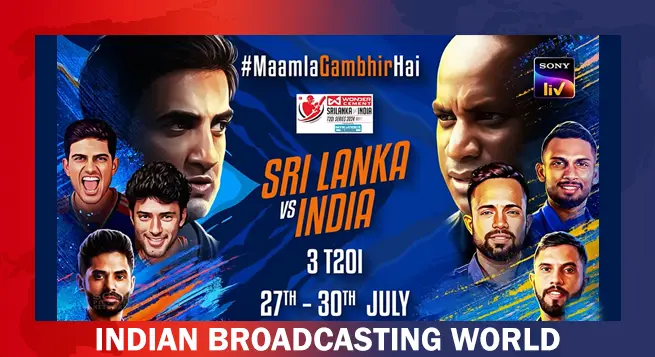 Sony LIV launches #MaamlaGambhirHai campaign
Sony LIV launches #MaamlaGambhirHai campaign 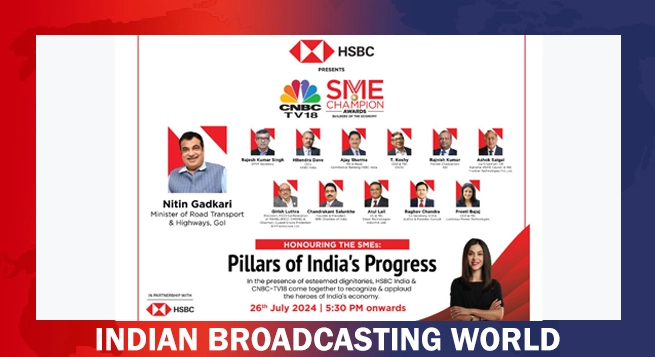 CNBC-TV18, HSBC India honor SMEs with Champion Awards
CNBC-TV18, HSBC India honor SMEs with Champion Awards 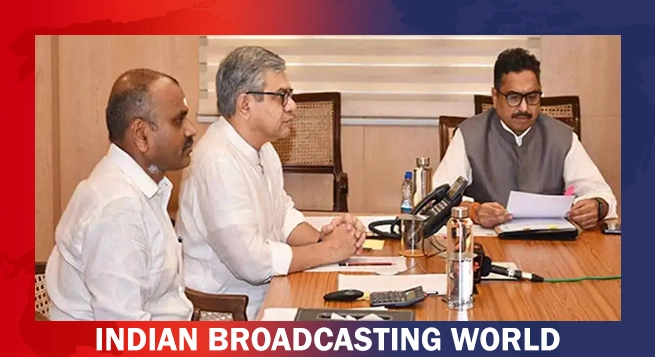 Ashwini Vaishnaw inaugurates ‘Apna Radio 90.0 FM’ at IIMC Aizawl
Ashwini Vaishnaw inaugurates ‘Apna Radio 90.0 FM’ at IIMC Aizawl  ‘Sam Bahadur’ to premiere on Zee Cinema on July 28
‘Sam Bahadur’ to premiere on Zee Cinema on July 28 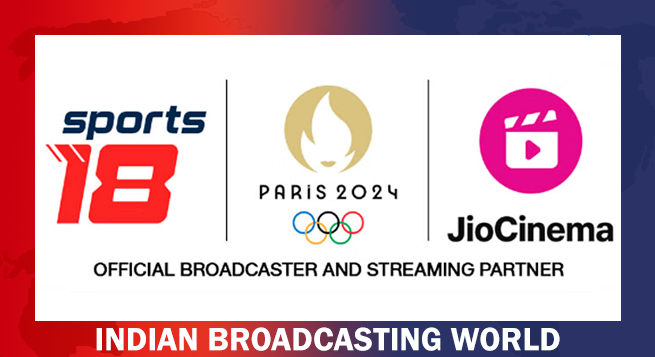 Viacom18 announces exclusive coverage of Olympic Games opening ceremony
Viacom18 announces exclusive coverage of Olympic Games opening ceremony 


